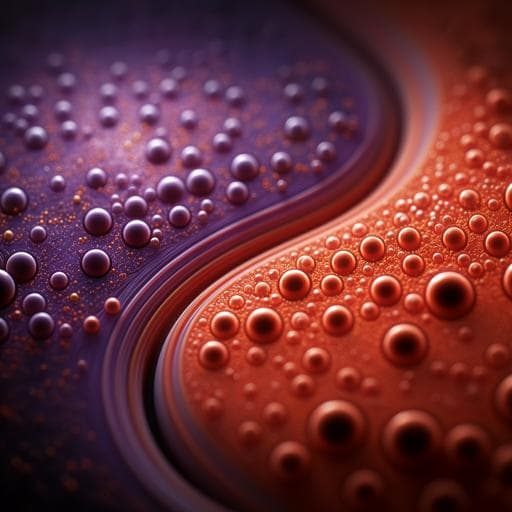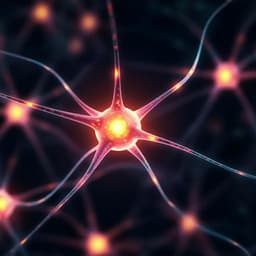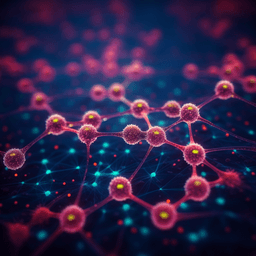
Engineering and Technology
Elasto-inertial microfluidic separation of microspheres with submicron resolution at high-throughput
H. Jeon, S. H. Lee, et al.
This innovative research by Hyunwoo Jeon, Song Ha Lee, Jongho Shin, Kicheol Song, Nari Ahn, and Jinsoo Park delves into a dimensionless analysis for the precise estimation of microsphere behaviors in elasto-inertial microfluidic separation. Discover how new dimensionless numbers can enhance microsphere migration predictions and achieve impressive separation results.
~3 min • Beginner • English
Introduction
The study addresses the need for high-resolution, high-throughput microfluidic separation of micron and submicron-scale objects, such as blood cells, platelets, and bacteria. Conventional passive (inertial focusing, pinched flow, Dean flow fractionation, deterministic lateral displacement) and active (opto-, dielectro-, magneto-, and acoustophoresis) techniques face trade-offs among precision, device complexity, and throughput. Elasto-inertial microfluidics leverages viscoelastic fluids to introduce an elastic lift force that can yield single, well-defined equilibrium positions and improve separation resolution. However, guidance on tuning co-flows of Newtonian and viscoelastic fluids has been lacking, and standard dimensionless numbers (Re, Wi, El) are insufficient to predict particle behavior at the interface. This work proposes modified dimensionless parameters and a new interface-to-size metric to predict and control cross-interface migration, enabling submicron-resolution, high-throughput separation.
Literature Review
Prior work in passive microfluidics includes inertial focusing, pinched flow fractionation, Dean flow fractionation, and DLD, which offer simplicity and throughput but require precise tuning of geometry, fluid properties, and flow conditions. Active methods (opto-, dielectro-, magneto-, acoustophoresis) provide high precision but are complex and costly. In viscoelastic flows, elastic lift forces arising from normal stress differences enable distinct focusing behaviors and have achieved single equilibrium positions for microspheres. Co-flows of Newtonian and viscoelastic fluids have been used to enhance separation, typically analyzed with Reynolds number (Re), Weissenberg number (Wi), and elastic number (El = Wi/Re). Yet, these metrics, as commonly defined, do not fully capture particle behavior near co-flow interfaces. This study builds on these foundations by redefining key dimensionless parameters to better describe cross-interface migration.
Methodology
Device and working principle: A rectangular microfluidic device with two inlets (sample and sheath) and three outlets forms a three-layer co-flow (sample/sheath/sample). The sample is a Newtonian DI water suspension of polystyrene (PS) microspheres; the sheath is a dilute polyethylene oxide (PEO, Mw = 600 kDa, 100 ppm; Boger-like fluid) viscoelastic solution. The viscoelastic stream sandwiches the Newtonian streams mid-channel. Channel geometry used for interface studies: width w = 20 µm, height h = 50 µm.
Mechanism: Microspheres initially near the walls in the Newtonian streams experience wall-induced lift (Fw ∝ d) driving them away from the walls, shear-gradient lift acting toward the sidewalls, and, upon reaching the Newtonian/viscoelastic interface, an elastic lift force Fel = Cel δV N1 toward or away from the wall depending on their position relative to the interface. The first normal stress difference N1 = 2 μp λ γ^2 (Oldroyd-B) governs Fel magnitude. Larger particles more readily cross into the viscoelastic sheath and focus near the channel center; smaller particles remain in Newtonian streams and focus near side walls. Downstream trifurcation enables collection of large particles at the center outlet and small particles at side outlets.
Interface characterization: The Newtonian/viscoelastic interface position was quantified as the Newtonian half-width wN under varying flow rate ratios α = Qve/QN and absolute flow rates (QN = 1–10 µL/min). Red fluorescent 300-nm PS tracers in DI water (Newtonian) visualized wN at upstream, midstream, and near the three-outlet junction. Theoretically, wN(α) was predicted by solving 2D Poiseuille flow for the Newtonian stream u(y,z) in the rectangular cross-section and integrating to match QN, neglecting viscoelastic elastic effects.
Dimensionless analysis: Inertial effects characterized using Re = 2 ρve Qtotal / [ μve (w + h) ]. Traditional Wi = 2 λ Qtotal / (h w^2). Proposed modified Weissenberg number Wim = 2 λ Qve / (h μve^2), considering only the viscoelastic flow’s contribution to elasticity. Modified elastic number Elm = Wim / Re to compare elastic to inertial effects under co-flow. Additionally, a new geometric number χ = wN / d (Newtonian stream width normalized by particle diameter) was introduced to delineate regimes: inertial focusing (χ large), elasto-inertial transition (χ ≈ O(1)), and elastic focusing (χ small). Experimental campaigns used PS microspheres of diameters 2.1 and 3.2 µm (and later 2.5 µm) to validate predictions across varying α and flow rates.
Separation experiments: Utilizing the predicted regimes, separations of close-size beads (2.1 vs 2.5 µm; 2.5 vs 3.2 µm) were performed at high total flow rates to demonstrate high-throughput, collecting fractions at the three outlets and evaluating purity and recovery. Biological validation separated platelets from similar-sized Escherichia coli under analogous conditions.
Key Findings
- Interface behavior: Measured Newtonian stream width wN decreased with increasing α, broadly consistent with theory, but exhibited dependence on absolute flow rates at fixed α not captured by the ideal Poiseuille model. At low QN (e.g., 1 µL/min) and low α (1–4), insufficient inertial effect of the viscoelastic stream led to less stable co-flow and larger wN than predicted. A reversal was observed near α ≈ 5 where wN for QN = 10 µL/min exceeded that for QN = 1–5 µL/min due to the Newtonian stream’s higher inertia limiting interface displacement.
- Dimensionless framework: The proposed modified Weissenberg number (Wim) and modified elastic number (Elm = Wim/Re) better captured particle focusing and cross-interface migration trends in co-flows than traditional Wi and El that rely on Qtotal. Considering only the viscoelastic stream for elasticity reflected that Newtonian fluids (λ ≈ 0) do not contribute to elastic forces.
- New geometric metric: The dimensionless width χ = wN/d delineated three regimes—(i) inertial focusing (leq < wN), (ii) elasto-inertial transition (leq ≈ wN), and (iii) elastic focusing (leq > wN)—predicting whether particles cross into the viscoelastic stream.
- Predictive agreement: Theoretical estimation of cross-interface migration agreed with experiments using 2.1 and 3.2 µm PS beads in water/PEO co-flows over varied α and flow rates.
- Separation performance: Enabled submicron-resolution separation between 2.1 and 2.5 µm microspheres, and between 2.5 and 3.2 µm, achieving high purity (>95%) and high recovery (>97%) at high throughput.
- Biological validation: Successfully separated platelets from similar-sized Escherichia coli, demonstrating applicability to bio-particles.
Discussion
The study demonstrates that particle migration across a Newtonian/viscoelastic interface is governed by a balance of inertial (wall-induced and shear-gradient lift) and elastic lift forces, and critically by the interface’s position relative to particle equilibrium locations. Traditional dimensionless numbers using total flow fail to reflect the separate roles of the Newtonian and viscoelastic streams in co-flows. By introducing Wim and Elm, the analysis isolates the viscoelastic contribution to elasticity and enables quantitative comparison with inertia under varied co-flow conditions. The geometric metric χ = wN/d provides a practical design rule to place the interface relative to particle size, thus determining whether particles remain in the Newtonian streams or cross into the viscoelastic sheath. Together, these metrics accurately predict regimes of inertial focusing, elasto-inertial transition, and elastic focusing, guiding high-resolution separations. Experimental observations of interface sensitivity to absolute flow rates highlight real-device effects (e.g., stability at low Re) and support the need for the modified framework. The resulting separations at submicron resolution, with high purity and recovery, and successful platelet/E. coli separation, underscore the method’s relevance for high-throughput sample preparation and microfluidic cytometry.
Conclusion
This work establishes a predictive, dimensionless framework for elasto-inertial co-flow separations by introducing a modified Weissenberg number (Wim), modified elastic number (Elm), and a new geometric parameter (χ = wN/d). These parameters accurately predict cross-interface migration and focusing regimes, enabling submicron-resolution separations at high throughput with >95% purity and >97% recovery. Theory-experiment agreement was shown for 2.1–3.2 µm beads, and applicability was validated by separating platelets from similar-sized E. coli. Future work could generalize the framework across a broader range of channel geometries, polymer types and concentrations, and complex biological samples, as well as integrate real-time flow control to maintain target χ and Elm under varying sample conditions.
Limitations
- Theoretical interface predictions excluded elastic effects and did not fully capture experimentally observed dependence on absolute flow rates at fixed α, particularly at low Re where co-flows were less stable.
- Experiments were demonstrated in a specific channel geometry (w = 20 µm, h = 50 µm) and with a single dilute PEO formulation (100 ppm, Mw = 600 kDa), which may limit generalizability without further validation.
- Validation focused on specific bead sizes (2.1, 2.5, 3.2 µm) and one biological pair (platelets vs E. coli); broader size ranges and cell types were not reported in the provided text.
- Reynolds number was defined using viscoelastic properties due to similar fluid properties and higher sheath flow; systems with dissimilar fluids may require revisiting this assumption.
Related Publications
Explore these studies to deepen your understanding of the subject.







